Can You Catch Ringworm from Swimming Pools and Public Showers?
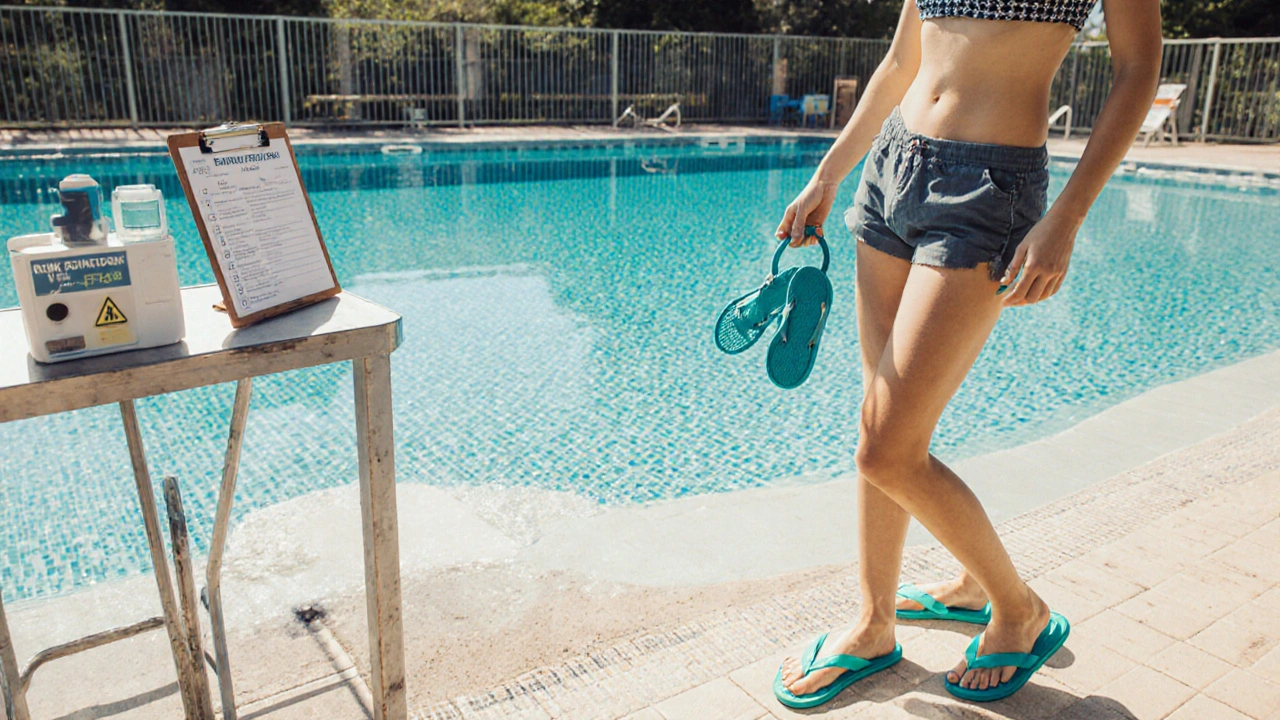
Ringworm Risk Assessment Tool
Your Risk Assessment
Recommendation:
Quick Takeaways
- Ringworm spreads via direct skin contact or contaminated surfaces called fomites.
- Well‑maintained public pools are low‑risk, but stagnant water and dirty edges can harbor fungi.
- Public showers are higher‑risk because they stay moist and are touched by many people.
- Typical signs include a red, scaly ring‑shaped patch that itches.
- Good hygiene, shower shoes, and prompt treatment cut the odds dramatically.
When you hear “Ringworm is a common fungal skin infection caused by dermatophytes,” you might picture a child scratching a rash on the arm. Most people assume it only spreads through direct skin‑to‑skin contact, but the truth is a bit messier. The fungus can live on wet surfaces, towels, even the grout in a pool deck. That’s why the question “Can you catch ringworm from swimming pools and public showers?” matters for anyone who loves a lap or a quick rinse after the gym.
The risk of a ringworm infection depends on three factors: how many fungal spores are present, how long they stay alive, and whether your skin is vulnerable. Below, we break down the science, walk through the hot spots, and give you a practical checklist to stay safe.
How Ringworm Spreads: The Science
Ringworm isn’t a worm at all. It’s a group of fungi collectively called dermatophytes. These microscopic organisms love warm, damp environments-exactly the conditions you find in pools, showers, locker rooms, and even on a sweaty yoga mat.
Two main routes let the fungus jump from place to place:
- Direct contact: Skin‑to‑skin contact with an infected person or animal.
- Indirect contact via fomites-objects or surfaces that have picked up spores. Wet floors, shared towels, and poolside benches count as fomites.
Once on a surface, the spores can survive for weeks if the area stays moist. That’s why “wet and shared” is a red flag for many skin infections, not just ringworm.
Are Swimming Pools a Hotspot?
A public swimming pool is a mixed bag. Properly chlorinated water kills most fungi within minutes, so a sparkling pool with a regularly checked chlorine level (< 1 ppm) is generally safe. However, problems arise when:
- Chlorine levels dip below 0.5ppm, especially in high‑traffic areas.
- Water isn’t filtered often enough, letting organic matter (skin cells, sweat) build up.
- Pool decks, railings, and benches stay damp and aren’t cleaned regularly.
The CDC’s 2023 water‑facility survey found that only 12% of sampled pools had chlorine levels low enough to permit fungal survival for more than 48hours. That’s a small slice, but it shows a risk exists when maintenance slips.
Practical tip: If the water looks cloudy, smells strong of chlorine, or the deck feels slick, it’s safer to skip the dip or at least wear water shoes and avoid sitting on wet benches.
Public Showers: What to Watch For
Public showers rank higher on the risk ladder. They stay moist 24/7, get heavy foot traffic, and often lack routine scrubbing. A study from the University of Alberta in 2024 swabbed 30 municipal shower stalls: 18% tested positive for dermatophyte DNA, compared with 3% of pool surfaces.
Key risk factors include:
- Floor tiles that are cracked or porous, allowing spores to hide.
- Shared benches or locker‑room benches that never dry.
- People walking in without shower shoes, leaving fungal spores on the floor.
Simple habits cut the odds dramatically: always wear flip‑flops, let the floor dry after you exit (step on a dry mat if available), and avoid sitting on wet benches.
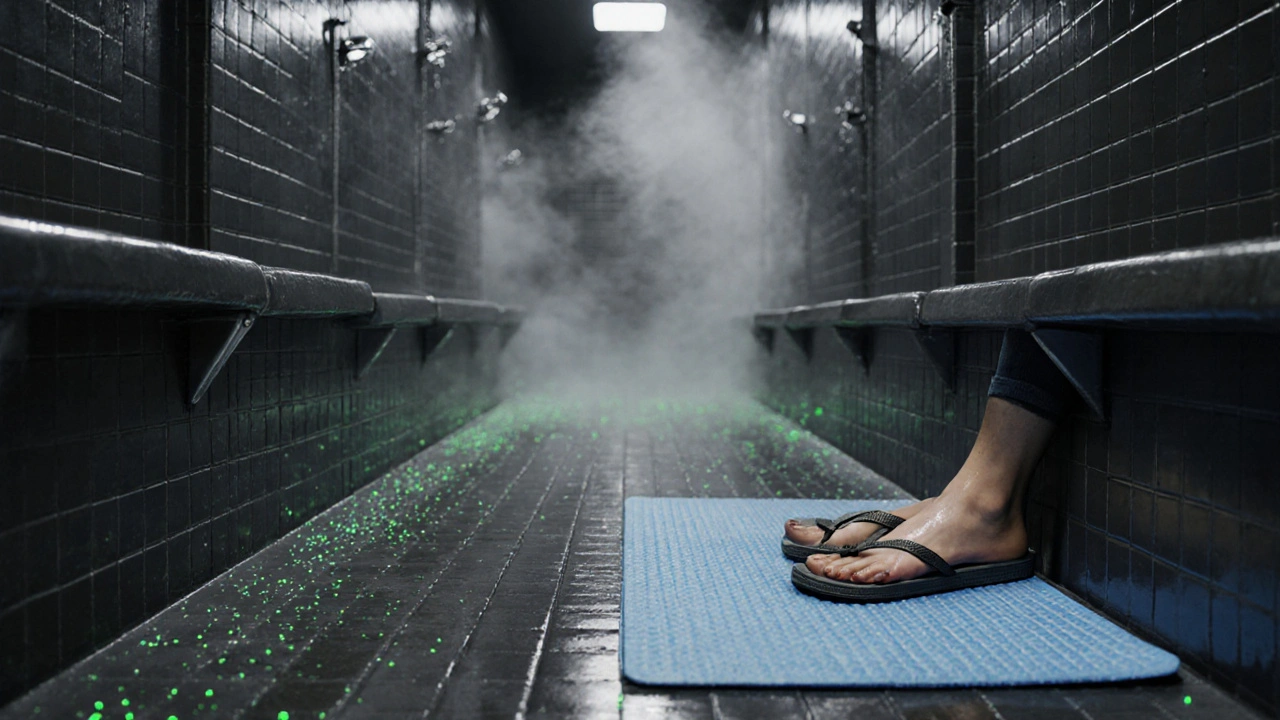
Other Common Hotspots (Gym Mats, Locker Rooms, Saunas)
| Location | Typical Moisture Level | Maintenance Frequency | Ringworm Risk |
|---|---|---|---|
| Public swimming pool | High (water) | Daily chlorine checks | Low‑to‑moderate |
| Public shower | Very high (continuous spray) | Weekly deep clean | Moderate‑to‑high |
| Gym mat/foam floor | Medium (sweat) | Weekly disinfect | Moderate |
| Sauna/steam room | High (steam) | Monthly deep clean | Low‑to‑moderate |
Notice the pattern: the wetter and less frequently scrubbed, the higher the risk. The table helps you decide where to be extra cautious.
Spotting Ringworm Early: The Classic symptom
Ringworm usually shows up within 4‑14days after exposure. Look for these tell‑tale signs:
- A round, red patch that expands outward, leaving a clearer center - the “ring”.
- Scaly or flaky edges that may crack.
- Itching, especially after sweating.
- In children, the rash often appears on the scalp or face; adults see it on the body or feet.
If you catch it early, treatment works fast and you’re less likely to spread it to others.
Treatment Options: From Over‑the‑Counter to Prescription
Most uncomplicated cases clear up with topical therapy. A treatment regimen typically looks like this:
- Apply an over‑the‑counter antifungal cream (clotrimazole, terbinafine, or miconazole) twice daily for 2‑4weeks.
- Keep the area clean and dry; pat it with a paper towel after showering.
- Wash anything that touched the rash (towels, bedding) in hot water (≥60°C) and dry on high heat.
If the rash covers a large area, involves the scalp, or doesn’t improve after a week, see a clinician. Prescription oral antifungals (e.g., terbinafine 250mg daily for 2‑4weeks) have a higher cure rate for stubborn cases.
Prevention Checklist: Stay Safe at Pools and Showers
- Wear flip‑flops or shower shoes on any wet surface.
- Dry your feet thoroughly after exiting a pool or shower.
- Bring your own towel; avoid sharing.
- If you have a known ringworm infection, skip communal water facilities until treatment finishes.
- Inspect pool decks and shower floors; report any standing water or mildew to staff.
- Apply an antifungal powder to feet if you frequent gyms or public showers.
These habits take seconds but protect you from a weeks‑long itch.
Mini FAQ
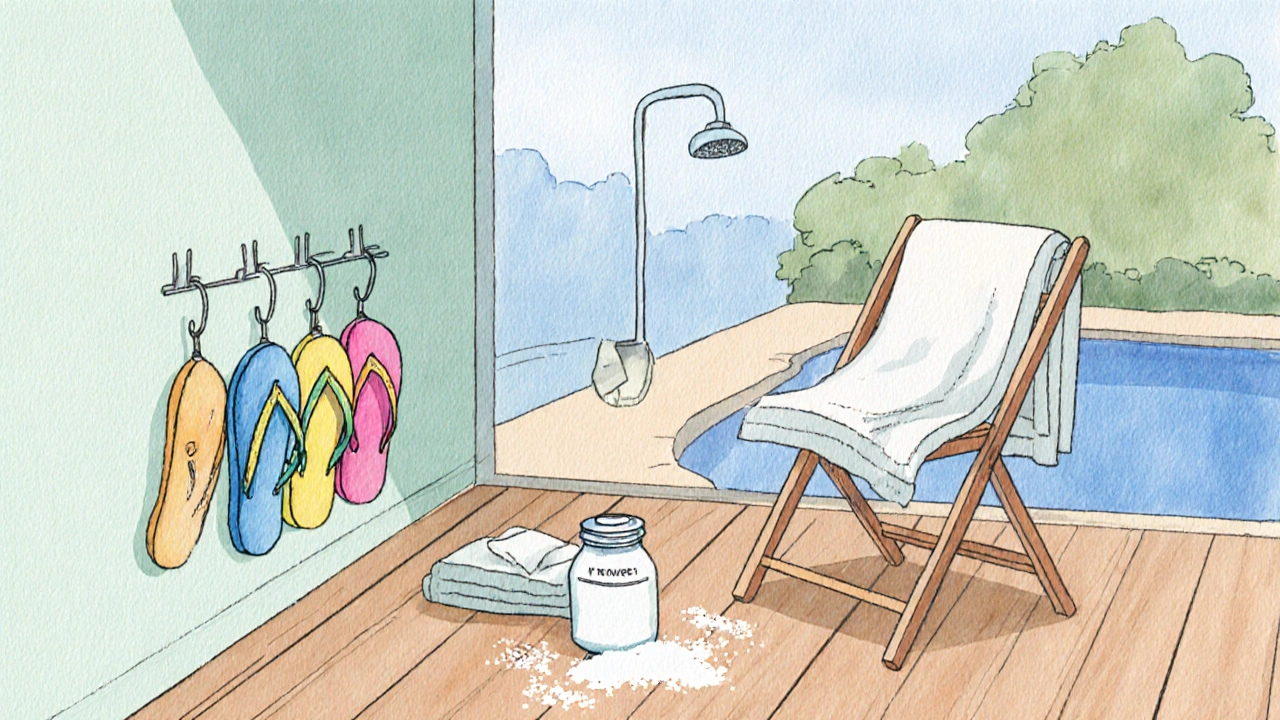
Frequently Asked Questions
Can you get ringworm from a chlorinated pool?
Only if the chlorine level is too low or the pool deck stays wet and dirty. Proper maintenance makes the risk very low.
Do public shower mats help prevent ringworm?
Yes. Mats that stay dry create a barrier between your skin and any spores left on the floor.
How long can dermatophyte spores survive on a shower floor?
In a moist, unclean environment they can live for weeks, sometimes up to two months.
What’s the fastest way to tell if a rash is ringworm?
Look for a circular, expanding patch with a clear center and raised, scaly edge. A quick visit to a pharmacist or doctor for a KOH test confirms it.
Can I still go swimming while I’m treating ringworm?
If the rash is covered with a waterproof bandage and you’ve cleaned the area well, most health guidelines allow it. However, many clinicians advise waiting until the infection clears to avoid spreading spores.
Bottom line: swimming pools are usually safe if they’re well‑maintained, but public showers can act as a breeding ground for ringworm spores. By staying aware of the environment, keeping your feet covered, and treating any rash quickly, you can enjoy the pool without the itch.



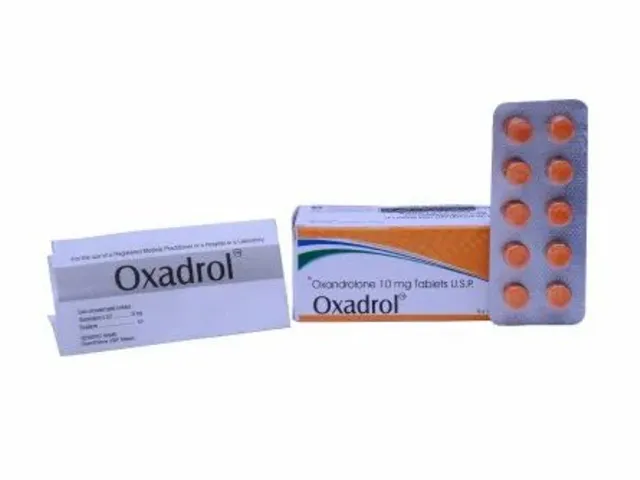

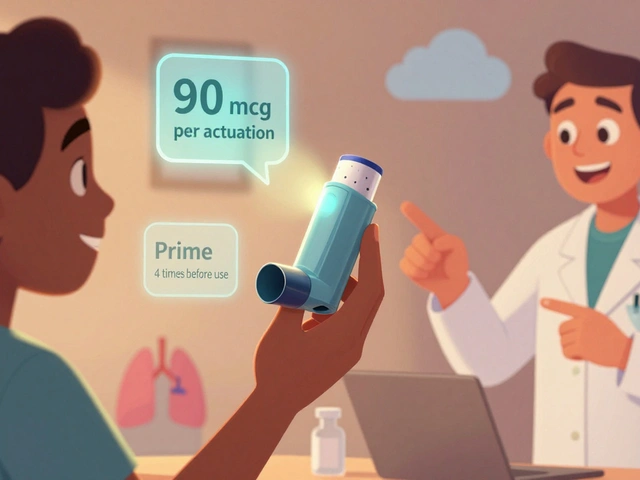
Craig Stephenson
October 4, 2025 AT 12:25Got the tool and ran a quick check on my local pool – all the basics are covered. The risk level came out moderate, which lines up with what we see most weekends. Keep those flip‑flops on and rinse off before heading home, that’s the simple part. A little awareness goes a long way, so stay safe and have fun.
Tyler Dean
October 9, 2025 AT 12:25If you think a public pool is clean, you’re buying the lie they sell about hygiene.
Susan Rose
October 14, 2025 AT 12:25In many cultures communal bathing is a sacred ritual, and they’ve got strict protocols that actually keep fungal spores at bay. Modern public pools often skip those old‑school practices, which can up the odds of ringworm spreading. So if you’re used to the meticulous cleansing rituals, you’ll notice the difference right away.
diego suarez
October 19, 2025 AT 12:25We have to respect that not every facility can guarantee perfection, but the basic principle stays the same: minimize skin-to-surface contact. Wearing shower shoes creates a barrier that most fungi can’t breach, and washing your hands after the locker room is a simple courtesy. If a place feels slippery or overly crowded, it’s worth reconsidering your exposure. Balance your enjoyment with a little common sense, and you’ll stay on the safe side.
Eve Perron
October 24, 2025 AT 12:25When we talk about ringworm, we’re really discussing a group of dermatophytes that thrive in warm, moist environments, and public pools can unfortunately provide exactly that niche if not properly managed. The first line of defense, of course, is the chemical balance of the water – chlorine, bromine, or other disinfectants must be maintained within strict parameters to suppress fungal growth. However, even a perfectly chlorinated pool can become a breeding ground if the surrounding surfaces, such as deck tiles and changing rooms, are neglected. A well‑kept facility typically implements a regular cleaning schedule that includes scrubbing all non‑water surfaces with antifungal agents. Moreover, the presence of a diligent maintenance staff that checks pH levels multiple a day is a hallmark of a responsible pool. In the same vein, public showers are often the hidden culprits because they are dark, damp, and see high traffic. If the shower floor is not regularly descaled and disinfected, microscopic spores can cling to the tiles and linger for weeks. Wearing flip‑flops or shower shoes creates a physical barrier that stops spores from making direct contact with bare skin, which is a simple yet highly effective precaution. The design of the facility also matters; modern showers equipped with proper drainage and ventilation reduce humidity, thereby cutting down spore viability. User behavior cannot be ignored either. People who walk barefoot, especially after a swim, carry residual water that can transfer organisms to the floor. Encouraging patrons to towel off before stepping onto shower mats can dramatically lower the chance of transmission. Some facilities go a step further by providing disposable shoe covers or even installing foot‑drying stations that blow warm air over the feet. Finally, education plays a crucial role. When staff post clear signage about the importance of footwear and hygiene, users are more likely to comply. In sum, while it is theoretically possible to contract ringworm from a poorly maintained pool or shower, a combination of proper chemical treatment, rigorous cleaning protocols, sensible facility design, and personal protective habits reduces the risk to a very low level. By adhering to these standards, both operators and patrons share the responsibility for keeping the environment safe and enjoyable for everyone.
Josephine Bonaparte
October 29, 2025 AT 11:25Look, you dont need a PhD to get that ringworm loves damp feet – just keep ur shoes on in the shower. If a place looks grubby, walk out, no shame. It’s not rocket science, u just wash and dry ur self good. Trust me, I seen too many cases from lol‑lazy facilities.
Meghan Cardwell
November 3, 2025 AT 11:25From an epidemiological standpoint, the incidence rate of tinea corporis spikes in environments where the basic “wet‑and‑dry” cycle is disrupted by sub‑optimal biocide concentrations. In layman’s terms, you’ve got a perfect incubator for keratinophilic fungi when the pool’s residual chlorine dips below the 1.0 ppm threshold and the surrounding deck retains moisture. The mycelial hyphae can adhere to synthetic fibers of swimwear, making secondary transmission a plausible vector. Deploying a multi‑modal mitigation strategy-chemical dosing, routine povidone‑iodine footbaths, and mandatory non‑slip footwear-acts synergistically to lower the basic reproduction number (R0) of the pathogen. In practice, this translates to fewer itchy lesions and a healthier community of swimmers.
stephen henson
November 8, 2025 AT 11:25Just a heads‑up: a quick rinse with antibacterial soap after the pool can cut down any stray spores you might have picked up. 🌊
And don’t forget to dry your toes thoroughly – fungi love the damp. 👍
Manno Colburn
November 13, 2025 AT 11:25Honestly, i think most peopel dont even realize how many places they can get ringworm besides the obvious ones – like the locker benches, the dry saunas, even the vending machine handles if they’re moist from condensation. The thing is, a lot of these spots get overlooked bc they dont look dirty at first glance, but the spores are there, waiting for a warm foot to land on them. So yeah, i would say wear flip‑flops everywhere, not just in the shower, and maybe carry a small hand sanitizer bottle just in case. It’s not about being paranoid, it’s about being smart, and the cost of a quick spray is nothing compared to the itch and the doctor visit later.
Namrata Thakur
November 18, 2025 AT 11:25Don’t let fear ruin your fun! With just a pair of shower shoes and a quick rinse, you’re practically invincible to ringworms. Imagine the pool as a giant playground – you just need to keep the rules in mind, and the experience stays joyful and safe.
Chloe Ingham
November 23, 2025 AT 11:25The truth is they’re hiding the real danger behind a glossy brochure, pushing the narrative that pools are spotless while the hidden corners breed unseen threats. Every time you step into that steamy shower, you’re stepping into a silent battlefield, and the only defense you have is awareness and protective footwear.
Mildred Farfán
November 28, 2025 AT 11:25Oh sure, because we all know that a public pool’s “clean” label automatically means it’s a fungus‑free zone. If you enjoy playing roulette with your skin, go ahead and skip the flip‑flops – just don’t be surprised when you start scratching like a cat.
Danielle Flemming
December 3, 2025 AT 11:25Yo, pool days are the best, but don’t be that guy who walks around barefoot like it’s a beach. Slip on some shower shoes, splash around, and keep the skin drama to a minimum – you’ll thank yourself later when there’s no itch‑fest ruining the vibe.
Anna Österlund
December 8, 2025 AT 11:25Listen up: if you think a little fungus can stop you, think again. Grab those shoes, stay sharp, and dominate the pool without letting ringworm cramp your style. No excuses, just action.